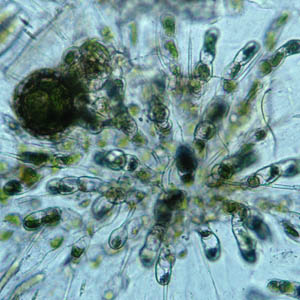Classification: Eukarya, Charophyta, Coleochaetophyceae, Coleochaetales, Coleochaetaceae
Synonomy:
Coleochaete pulvinata A. Braun ex Kütz, Sp. Alg.: 425, 1849. Type locality: Titisee, Germany. Lectotype: A. Braun s.n., "fertilis!" Titisee auf Nuphar spennerianum 15 aug 47" (L: 937.351.147), designated by Szymanska & Spalik (1993: 33).
Several forms:
C. pulvinata var indica B.N. Prasad and D. K. Asthana, Geophytology 7:38. 1975
C. pulvinata f major Pringsh., Jarb. Wiss. Bot. 2:33 tII: f. 1 1860.
C. pulvinata f. minor Pringsh. Jarb. Wiss. Bot. 2: 33, tII: f. 3; t. V: f. 13 1860
C. pulvinata f. pumila Cedergr., Ark. Bot. 25(4): 39. 1933.
Description: Thalli up to 1 mm in diameter, with both prostrate and erect filaments, both of which branch and are multicellular with numerous hairs. There is a layer of mucilage covering the entire thallus. Antheridia are flask-shaped and appear as small branches that spiral around the antheridial mother cell. Egg cells have long trichogynes and are at the end of a filament when receptive. Subsequent growth of the thallus can place maturing zygotes closer to the center of the thallus. Zygotes are corticated following fertilization, and in temperate climates persist through the winter, germinating in the Spring. Germination yields at least eight meiospores.
It is within the C. scutata subgenus (Delwiche et al., 2002).
An excellent series of micrographs showing the stages of the life cycle of C. pulvinata has been prepared by Linda Graham.

Coleochaete pulvinata from Lake Tomohawk, Oneida Co., WI
SCALE. [SOURCE, DATE, ETC]
Coleochaete pulvinata is named for its cushion-like thalli.
In our experience there is substantial variation among specimens, probably reflecting several poorly characterized species. The named forms do not adequately represent this diversity.
Additional Information
How to find it: Coleochaete pulvinata is common and easy to recognize, although we believe that there are multiple undescribed species hidden within this morphological species. Its multicellular upright branches are distinctive among named species.
How to grow it: C. pulvinata can be grown easily in Guillard's Freshwater Medium, also called "Woods Hole" Freshwater medium. Unialgal cultures are most easily established by zoospore isolation.
Key Literature: Pringsheim, 1860. Graham, 1984. Delwiche et al., 2002.
Zygote cortication in C. pulvinata prostrate filaments
Authors for this web page: Charles Delwiche, Matthew Cimino